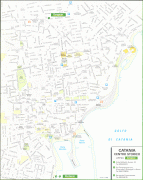Catania
 |
 |
Catania was founded in the 8th century BC by Chalcidian Greeks. The city has weathered multiple geologic catastrophes: it was almost completely destroyed by a catastrophic earthquake in 1169. A major eruption and lava flow from nearby Mount Etna nearly swamped the city in 1669 and it suffered severe devastation from the 1693 Sicily earthquake.
During the 14th century, and into the Renaissance period, Catania was one of Italy's most important cultural, artistic and political centres. It was the site of Sicily's first university, founded in 1434. It has been the native or adopted home of some of Italy's most famous artists and writers, including the composers Vincenzo Bellini and Giovanni Pacini, and the writers Giovanni Verga, Luigi Capuana, Federico De Roberto and Nino Martoglio.
Catania today is the industrial, logistical, and commercial center of Sicily. Its airport, the Catania-Fontanarossa Airport, is the largest in Southern Italy. The central "old town" of Catania features exuberant late-baroque architecture, prompted after the 1693 earthquake, and is a UNESCO World Heritage Site.
The ancient indigenous population of the Sicels named their villages after geographical attributes of their location. The Sicilian word, katane, means "grater, flaying knife, skinning place" or a "crude tool apt to pare". Other translations of the name are "harsh lands", "uneven ground", "sharp stones", or "rugged or rough soil". The latter etymologies are easily justifiable since, for many centuries following an eruption, the city has always been rebuilt within its black-lava landscape.
Around 263 BC, the city was variously known as Catĭna and Catăna (Κατάνη ). The former has been primarily used for its supposed assonance with catina, the Latin feminization of the name catinus. Catinus has two meanings: "a gulf, a basin or a bay" and "a bowl, a vessel or a trough", thanks to the city's distinctive topography.
Around 900, when Catania was part of the emirate of Sicily, it was known in Arabic as Balad al-fīl (بلد الفيل) and Madīnat al-fīl (مدينة الفيل), respectively meaning "the Village (or Country) of the Elephant" and "the City of the Elephant". The Elephant likely referred to the ancient lava sculpture, now placed over the fountain in Piazza Duomo. The sculpture is most likely a prehistoric sculpture that was reforged during the Byzantine Era, prized as a protective talisman against enemies, both human, natural or geologic. Another Arab toponym was Qaṭāniyyah (قطانية), allegedly from the Arabic word for the "leguminous plants". Pulses like lentils, beans, peas, broad beans, and lupins were chiefly cultivated in the plains around the city well before the arrival of Aghlabids. Afterwards, many Arabic agronomists developed these crops and the citrus orchards in the area around the city. The toponym Wādī Mūsá (وادي موسى), or "the Valley of Moses" (from the Arabic name of the Simeto River), was rarely used.
Map - Catania
Map
Country - Italy
 |
 |
| Flag of Italy | |
Italy was the native place of many civilizations such as the Italic peoples and the Etruscans, while due to its central geographic location in Southern Europe and the Mediterranean, the country has also historically been home to myriad peoples and cultures, who immigrated to the peninsula throughout history. The Latins, native of central Italy, formed the Roman Kingdom in the 8th century BC, which eventually became a republic with a government of the Senate and the People. The Roman Republic initially conquered and assimilated its neighbours on the Italian peninsula, eventually expanding and conquering a large part of Europe, North Africa and Western Asia. By the first century BC, the Roman Empire emerged as the dominant power in the Mediterranean Basin and became a leading cultural, political and religious centre, inaugurating the Pax Romana, a period of more than 200 years during which Italy's law, technology, economy, art, and literature developed.
Currency / Language
| ISO | Currency | Symbol | Significant figures |
|---|---|---|---|
| EUR | Euro | € | 2 |
| ISO | Language |
|---|---|
| CA | Catalan language |
| CO | Corsican language |
| FR | French language |
| DE | German language |
| IT | Italian language |
| SC | Sardinian language |
| SL | Slovene language |





















